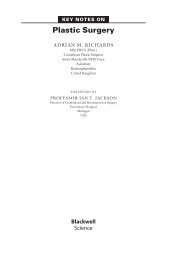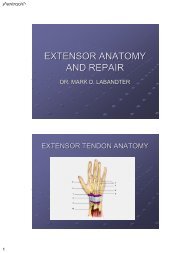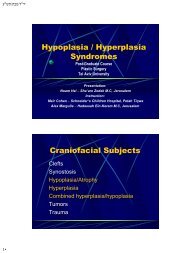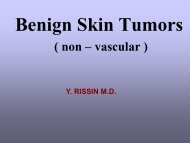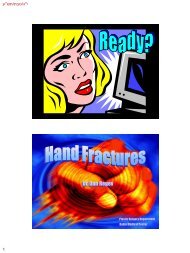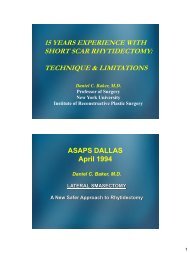ALLOPLASTIC MATERIALS IN PLASTIC SURGERY
ALLOPLASTIC MATERIALS IN PLASTIC SURGERY
ALLOPLASTIC MATERIALS IN PLASTIC SURGERY
You also want an ePaper? Increase the reach of your titles
YUMPU automatically turns print PDFs into web optimized ePapers that Google loves.
ע"<br />
שת/<br />
תבט/<br />
ד"<br />
י<br />
1<br />
<strong>ALLO<strong>PLASTIC</strong></strong> <strong>MATERIALS</strong><br />
<strong>IN</strong> <strong>PLASTIC</strong> <strong>SURGERY</strong><br />
David Leshem M.D.<br />
DEPARTMENT OF <strong>PLASTIC</strong> <strong>SURGERY</strong><br />
TEL AVIV SOURASKY MEDICAL CENTER<br />
January 2001<br />
ALLOPLASTS – DEF<strong>IN</strong>ITIONS<br />
• Foreign, non-autogenous materials implanted into tissues for purpose of<br />
augmenting, reconstructing or replacing tissues, organs or functions of the<br />
body.<br />
• Does not depend on local tissues for survival.<br />
• Temporary implants must disintegrate gradually within a predictable time<br />
without the production of non-compatable, harmful disintegration products.<br />
• Permanent implants must provide maintenance-free function in a<br />
physiologic environment over the patient’s lifetime.<br />
• Advantageous because: 1. No donor site morbidity.<br />
2.Unlimited availability.<br />
3.No operative time for harvesting the graft.
ע"<br />
שת/<br />
תבט/<br />
ד"<br />
י<br />
2<br />
Criteria for the IDEAL ALLOPLAST (Scales)<br />
1. Not physically modified by soft tissue.<br />
2. Chemically inert.<br />
3. Elicits no inflammatory or foreign body reaction.<br />
4. Non-carcinogenic.<br />
5. Produces no state of allergy or hypersensitivity.<br />
6. Resists mechanical strains.<br />
7. Capable of fabrication in the form desired.<br />
8. Sterilizable.<br />
9. Effective in its intended application.<br />
10. Temporary (degradable) implants must resorbe in<br />
predictable non-toxic fashion.<br />
Biocompatibility (Williams)<br />
“A state of affairs when a biomaterial exists<br />
within a physiologic environment without<br />
either the material adversely and<br />
significantly affecting the body, or the<br />
environment of the body adversely and<br />
significantly affecting the material.”
ע"<br />
שת/<br />
תבט/<br />
ד"<br />
י<br />
3<br />
Mechanical properties<br />
Mechanical properties<br />
• Elastic: X-Y<br />
• Plastic: Y-F<br />
• D: Permanent deformation<br />
• U: Ultimate strength<br />
• F: Ultimate failure
ע"<br />
שת/<br />
תבט/<br />
ד"<br />
י<br />
4<br />
Mechanical properties<br />
• Brittle - Ceramics<br />
• Ductile - Metals<br />
• Rubbery - Polymers<br />
Bone – intermediate<br />
(ceramic & polymer)<br />
Mechanical properties<br />
• Load – static or cyclic<br />
• Fatigue curve –<br />
interplay load repetition<br />
• Endurance limit – load<br />
below applied repetitively<br />
without failure.
ע"<br />
שת/<br />
תבט/<br />
ד"<br />
י<br />
5<br />
• Toxicity<br />
• Immunogenicity<br />
Biologic properties<br />
• Carcinogenicity (Solid state Carcinogenicity theory)<br />
• Efficacy<br />
• Potentiation of infection<br />
• Porosity and tissue ingrowth<br />
<strong>ALLO<strong>PLASTIC</strong></strong> IMPLANT CONSIDERATIONS<br />
TISSUE BED<br />
• Tension of soft tissue closure<br />
• Thickness of overlying soft tissue<br />
• Mobility of surrounding tissues<br />
• Vascularity of recipient site<br />
• Adequacy of pocket dissection<br />
• Proximity to bacteria-laden cavities<br />
• Exposure to mechanical loading
ע"<br />
שת/<br />
תבט/<br />
ד"<br />
י<br />
6<br />
<strong>ALLO<strong>PLASTIC</strong></strong> IMPLANT CONSIDERATIONS<br />
IMPLANT CHARACTERISTICS<br />
• Flexibility<br />
• Hardness<br />
• Surface texture<br />
• Porosity<br />
• Antibiotic absorption<br />
• Ease of material contouring<br />
• Adaptability to recipient site<br />
• Implant fixation<br />
TECHNICAL CONSIDERATION WHEN<br />
IMPLANT<strong>IN</strong>G ALLOPLAST<br />
• Ensure medical acceptability & quality controlled material.<br />
• Suitable mechanical properties for role.<br />
• Avoid chemical sterilization.<br />
• Avoid sharp edges and corners.<br />
• Stable tension free tissue coverage.<br />
• Avoid hematoma or dead space in recipient pocket.<br />
• Remote incision site.<br />
• Avoid soiling the implant.<br />
• Minimal or no implant mobility.
ע"<br />
שת/<br />
תבט/<br />
ד"<br />
י<br />
7<br />
COMPLICATIONS OF IMPLANT<strong>IN</strong>G<br />
ALLOPLASTS<br />
• Implant does not fulfill the intended role.<br />
• Mechanical failure.<br />
• Infection of implant.<br />
• Severe or persistent inflammation around the implant.<br />
• Immune alterations secondary to the implant.<br />
• Toxicity or carcinogenicity.<br />
• Exposure and/or extrusion.<br />
• Excessive capsule formation.<br />
• Capsular contracture.
ע"<br />
שת/<br />
תבט/<br />
ד"<br />
י<br />
8<br />
CLASSIFICATION OF ALLOPLASTS<br />
By composition<br />
• Metals Corrodible -stainless steel<br />
Noncorrodible -vitallium<br />
-titanium<br />
• Polymers Nonelastomeric -polyamide<br />
-polyesters<br />
-polyethylenes<br />
-polyurethanes<br />
-polymethylmethacrylate<br />
-polypropylene<br />
Elastomeric -silicones<br />
• Ceramics -tricalciumphosphates<br />
-hydroxyapatite<br />
CLASSIFICATION OF ALLOPLASTS<br />
By resorbability<br />
• Resorbable<br />
• Nonresorbable<br />
By Origin<br />
• Natural<br />
• Synthetic<br />
• Semisynthetic
ע"<br />
שת/<br />
תבט/<br />
ד"<br />
י<br />
9<br />
METALS<br />
• Uses: skeletal application<br />
skin staples<br />
suture<br />
• Biocompatability: release of ions – toxicity<br />
• Saline environment – corrosion<br />
• Oxide layer – resistance to corrosion<br />
• Corrosion – pain and tenderness, possible<br />
erythema and sinus tract<br />
STA<strong>IN</strong>LESS STEEL<br />
• Alloy – iron, nickel, molybdenum,<br />
chromium oxide.<br />
• Annealed – ductile (plastic deformation)<br />
• Cold worked – stronger
ע"<br />
שת/<br />
תבט/<br />
ד"<br />
י<br />
10<br />
Advantages<br />
STA<strong>IN</strong>LESS STEEL<br />
• Extensive experience<br />
• Easily fabricated<br />
• Readily available<br />
Uses<br />
• Plates<br />
• Screws<br />
• K wires<br />
Disadvantages<br />
• Corrosion (removal 2-5y)<br />
• Annealed easily<br />
deformed<br />
• Scatter on CT scan<br />
STA<strong>IN</strong>LESS STEEL
ע"<br />
שת/<br />
תבט/<br />
ד"<br />
י<br />
11<br />
VITALLIUM<br />
Alloy – chromium, cobalt<br />
Advantages<br />
• Corrosion resistant<br />
• Fatigue resistance<br />
• Strength<br />
• Little scatter on CT scan<br />
Disadvantages<br />
• Brittle<br />
• Premature fracture<br />
Uses<br />
• Fracture plates (Luhr mandibular compression and<br />
miniplates)<br />
TITANIUM<br />
• Pure – element 22 (grade 1-4)<br />
• Alloy – Ti6Al4V (grade 5)<br />
• Fabrication more difficult then stainless or<br />
vitalium
ע"<br />
שת/<br />
תבט/<br />
ד"<br />
י<br />
12<br />
Advantages<br />
• Strong<br />
• Light weight<br />
• Ductile<br />
• Corrosion resistant<br />
• Little scatter on CT<br />
Uses<br />
• Fracture plates<br />
• Screws<br />
• Mesh<br />
TITANIUM<br />
Disadvantages<br />
• Difficult and<br />
expensive to<br />
manufacture<br />
TITANIUM<br />
• Osseointegrated implants (dental implants)<br />
• Bone-anchored suturing devices
ע"<br />
שת/<br />
תבט/<br />
ד"<br />
י<br />
13<br />
OSSEO<strong>IN</strong>TEGRATED<br />
IMPLANTS<br />
OSSEO<strong>IN</strong>TEGRATION – Direct contact<br />
between metal and bone, without a fibrous<br />
interface, at light microscopic level.<br />
(Branemark)
ע"<br />
שת/<br />
תבט/<br />
ד"<br />
י<br />
14<br />
GOLD<br />
• Gold plate repair of cleft palate - 1565<br />
• Nobel element - number 76 on periodic table<br />
• No oxide layer<br />
• Lack of strength – softness<br />
• Expensive<br />
• Upper eyelid weight – 0.6-1.6 gr. (ptosis)<br />
POLYMERS<br />
• Polymers – long chins of repeating units<br />
that can reach massive molecular weights.<br />
• Mainly used for soft tissue applications
ע"<br />
שת/<br />
תבט/<br />
ד"<br />
י<br />
15<br />
POLYMERS<br />
Properties determined by<br />
• Chemical composition<br />
• Ester and amide links permit enzymatic<br />
degradation<br />
• Linear, branched and cross link – viscosity<br />
• Length of chain: low mwt – liquid<br />
increase mwt gel solid elastomer<br />
Polyethylene<br />
• Nonresorbable, synthetic, relatively LMWT<br />
• Manufactured in forms with increasing strength and<br />
stiffnes:<br />
low density – LDPE<br />
high density – HDPE<br />
ultrahigh density – UHDPE<br />
• Porous and woven forms allow fibrovascular ingrowth
ע"<br />
שת/<br />
תבט/<br />
ד"<br />
י<br />
16<br />
Disadvantages<br />
Polyethylene<br />
• Solid form difficult to sculpt<br />
• Mild persistent chronic foreign body<br />
reaction<br />
• Not autoclavabel (melts)<br />
Polyethylene<br />
Uses<br />
• Porous solid (Plastipore, Medpor) –<br />
augmentation implants, orbital floor<br />
reconstruction. (pore size 100-250m –<br />
fibrovascular ingrowth).<br />
• UHDPE – component of artificial joints<br />
• Marlex – abd. & chest wall recon., superior<br />
tensile strength. Not autoclavabel.
ע"<br />
שת/<br />
תבט/<br />
ד"<br />
י<br />
17<br />
Polypropylene<br />
• Nonresorbable, synthetic.<br />
• Highly inert.<br />
• Similar properties of polyethylene.<br />
• Can be autoclaved.<br />
Uses<br />
Woven mesh (Prolene), suture.<br />
Polytetrafluoroethylene (PTFE)<br />
• Non-resorbable, synthetic<br />
• Inert, antifriction and non-adhesive properties<br />
• Low tensile strength, pliable.<br />
uses<br />
• Woven – vascular prosthesis<br />
– suture coating - antifriction
ע"<br />
שת/<br />
תבט/<br />
ד"<br />
י<br />
18<br />
Polytetrafluoroethylene (PTFE)<br />
Proplast – PTFE combined with fiber,<br />
increased porosity and tissue ingrowth for<br />
stabilization.<br />
• Proplast 1 – graphite<br />
• Proplast 2 – alumina<br />
• Proplast HA – hydroxyapatite<br />
Polytetrafluoroethylene (PTFE)<br />
Proplast<br />
• Augmentation – chin, malar, nose.<br />
• Black – not for subcutaneous use.<br />
• Removed from market – biomechanical<br />
failure and foreign body reaction in TMJ<br />
reconstruction.
ע"<br />
שת/<br />
תבט/<br />
ד"<br />
י<br />
19<br />
Polytetrafluoroethylene (PTFE)<br />
GORTEX – expanded PTFE<br />
• Inert, non-allergenic, non-carcinogenic.<br />
• Low infection rate.<br />
Uses<br />
• Sutures.<br />
• Soft tissue patches.<br />
• Subcutaneous augmentation materials – lip,<br />
chin, nasal, malar, forehead and muscle sling.<br />
• Dura defects.<br />
Polyurethane<br />
• Alternating hard (urethane) and soft (polyether)<br />
segments.<br />
Uses<br />
• Meme, Ashley natural Y breast implant – open cell<br />
PU foam coating for breast implant<br />
- allow tissue ingrowth in mammary pocket<br />
and reduced rate of capsular contracture.<br />
- PU foam fragmented and degraded releasing<br />
potentially toxic breakdown products.<br />
- No reports of cancer caused by PU – removed from<br />
market 1991
ע"<br />
שת/<br />
תבט/<br />
ד"<br />
י<br />
20<br />
Polyester<br />
• Most widely used family of biomaterials in<br />
surgery.<br />
• Synthetic polymers with repeating carbonoxygen<br />
esoteric groups.<br />
• Chemical structure variation – permanent<br />
Polyester<br />
Polyethylene terephthalate<br />
• Most common of the Polyesters.<br />
• Widely used in the textile industry.<br />
– resorbable<br />
• Permits tissue anchoring to smooth substrate.<br />
• Early fibrous encapsulation with minimal<br />
foreign body reaction.
ע"<br />
שת/<br />
תבט/<br />
ד"<br />
י<br />
21<br />
Uses<br />
Polyester<br />
• Dacron – arterial prostheses, suture material.<br />
• Mersilene – abd. & chest wall reconstruction,<br />
facial onlay augmentation.(genioplasty)<br />
• Xomed – reinforced with polyurethane,<br />
craniofacial reconstruction.<br />
Polyester<br />
Aliphatic polymers<br />
• More then 20 years of use.<br />
• Resorbable – hydrolysis of ester bond<br />
• Sutures –Dexon (polyglycolic acid)<br />
–Vicryl (polyglactin–polyglycolic/lactic)<br />
– Maxon (polyglyconate)<br />
– Monocryl (polyglecaprone 25)
ע"<br />
שת/<br />
תבט/<br />
ד"<br />
י<br />
22<br />
Polyester<br />
LactoSorb – 82% polylactic and 18% polyglycolic acid<br />
• Bone fixation device.<br />
• Strength – 6 to 8 weeks.<br />
• Complete resorption – approx. 1 year.<br />
Polymethylmethacrylate<br />
• Non-resorbable, inert synthetic polymer.<br />
• Hard transparent resin.<br />
• Prefabricated or shaped at surgery.<br />
• Exothermic reaction - 80ºc, 8-10 min.
ע"<br />
שת/<br />
תבט/<br />
ד"<br />
י<br />
23<br />
Polymethylmethacrylate<br />
Advantages<br />
• Inexpensive<br />
• Once cured, it can be contoured with burrs.<br />
• Can be custom prefabricated.<br />
• Radiolucent.<br />
• Dureable.<br />
• Biocompatible.<br />
• Low thermal conductivity.<br />
Polymethylmethacrylate<br />
Disadvantages<br />
• Offensive odor - allergic reaction.<br />
• High cure temperature – require irrigation.<br />
• High bacterial adhesion.
ע"<br />
שת/<br />
תבט/<br />
ד"<br />
י<br />
24<br />
Uses<br />
Polymethylmethacrylate<br />
• Cranioplasty.<br />
• Orthopedic surgery – bone cement.<br />
• Impregnated with gentamicin – infected<br />
long bone fractures.<br />
Polymethylmethacrylate<br />
HTR-PMI – Composite: Polymethylmethacrylate and<br />
Polyhydroxyethylmethacrylate<br />
• Significant strength.<br />
• Porosity.<br />
• Hydrophilicity.<br />
• Calcium hydroxide coating – negative charge.<br />
• Preformed craniofacial implant.<br />
• Extensive fibrovascular ingrowth, limited<br />
bony ingrowth.
ע"<br />
שת/<br />
תבט/<br />
ד"<br />
י<br />
25<br />
• Derivatives of nylon.<br />
Polyamides<br />
• Nonresorbable inert alloplast.<br />
• Hydroscopic, unstable in vivo.<br />
• Degraded, mild foreign body reaction.<br />
• Supramid – mesh – not in use.<br />
uses<br />
• Suture material.<br />
Polydimethylsiloxane - SILICONE<br />
• Nonresorbable synthetic polymer containing<br />
noncarbon chain, repeating - (Si – O) – backbone<br />
with organic groups (methyl) attached to the<br />
silicone atom.<br />
• Silicone – generic name for high MWT polymer<br />
• Liquid oil, gel or rubber elastomer.<br />
• Viscosity – length of chain and crosslinking.<br />
• Silica particles added to rubbery form – increase<br />
tensile strength.
ע"<br />
שת/<br />
תבט/<br />
ד"<br />
י<br />
26<br />
SILICONE<br />
Properties<br />
• Thermal and oxidative stability.<br />
• Resistance to weathering.<br />
• Hydrophobic nature.<br />
• Low surface tension.<br />
• Good dielectric strength.<br />
• Versatility of structural forms.<br />
• Nonporous – resist tissue ingrowth.<br />
• Gas or steam sterilized.<br />
Properties – cont.<br />
SILICONE<br />
• Chemically and physically inert – controversial<br />
• Degrades in water, soil, air and in-vivo.<br />
• Shell of breast implant – semipermeable – bleeds
ע"<br />
שת/<br />
תבט/<br />
ד"<br />
י<br />
27<br />
Local reaction to silicone<br />
Injected liquid silicone oil-<br />
• Granulomatous reaction locally and<br />
regional lymph nodes.<br />
• Chronic infection, tissue breakdown and<br />
extrusion.<br />
• Impurities ? Reported in medical grade.<br />
• Liquid silicone not recommended.<br />
Local reaction to silicone<br />
Silicone gel-<br />
• Breast implant bleed or rupture – increase<br />
capsular contracture – Si in capsule.<br />
• Ab. Found in serum - after rupture.<br />
• Siliconomas – granulomas after rupture or<br />
bleed.<br />
Histology – phagocytic cells – silicone.<br />
Chronic inflammatory reaction, foreign body<br />
reaction.
ע"<br />
שת/<br />
תבט/<br />
ד"<br />
י<br />
28<br />
Local reaction to silicone<br />
Silicone elastomer-<br />
• May cause capsular contracture.<br />
• Persistent seromas.<br />
Silicone synovitis-<br />
• Infrequent severe synovial inflammatory<br />
response to silicone joint implants.<br />
• Reaction to fragmented particles.<br />
systemic reaction to silicone<br />
• Hematogenous and lymphatic dissemination.<br />
• Human Adjuvant Disease (HAD) – Miyoshi 1973<br />
- stimulation of autoimmune mediated illness after<br />
implantation of foreign body.<br />
- nonspecific connective tissue symptoms (fever,<br />
malasie, arthralgia, arthritis, lymphadenopathy,<br />
ESR, +Rh factor).
ע"<br />
שת/<br />
תבט/<br />
ד"<br />
י<br />
29<br />
systemic reaction to silicone<br />
Connective tissue disease-<br />
• Controversial – whether silicone and CT<br />
dis. Are related.<br />
• RA, Scleroderma, SLE, Sjogren’s, Mixed<br />
CT dis., etc.<br />
• Scleroderma most commonly associated<br />
with breast implants.<br />
• Epidemiologic studies – no risk of CT dis.<br />
systemic reaction to silicone<br />
Malignancy-<br />
• Silicone injected into mice is carcinogenic.<br />
• No evidence that silicone is carcinogenic in<br />
humans.
ע"<br />
שת/<br />
תבט/<br />
ד"<br />
י<br />
30<br />
Uses of silicone<br />
Silicone rubbers have been implanted every where in<br />
the body.<br />
• Orbital floor recon. – Silastic sheets<br />
• Malar augmentation – preformed implants<br />
• Maxillary and zygomatic recon. – custom implants<br />
• Chin augmentation – prefabricated implants<br />
• Mandibular condyle – silicon blocks (no longer)<br />
• Ear recon. – custom implants<br />
• Nasal augmentation - preformed implants and block<br />
Uses of silicone – con.<br />
• Breast augmentation and reco. - preformed implants<br />
• Small joint arthroplasty: hand - preformed implants<br />
• First stage tendon recon. – silastic rods<br />
• Cranioplasty & forehead contouring – prefabricated<br />
implants<br />
• Tissue expansion - prefabricated expanders<br />
• Scar revision – silastic sheets
ע"<br />
שת/<br />
תבט/<br />
ד"<br />
י<br />
31<br />
Properties-<br />
Ceramics<br />
• Brittle – minimal deformation per unit force.<br />
• Strong compressive strength.<br />
• Weakened by flaws, microcracks and porosity.<br />
• Highly inert.<br />
• Used as bone substitutes, not in load bearing<br />
areas.<br />
Hydroxyapatite (HA)<br />
• Most common apatite crystal is calcium HA<br />
• Synthetic varieties:<br />
- sintering Ca and P particles<br />
- dense or porous<br />
• Natural varieties:<br />
- porous coralline HA (50-200m)<br />
• No inflammatory or foreign body giant cell response<br />
• Bone regeneration by osteoconduction (scaffold)<br />
• No osteoinduction
ע"<br />
שת/<br />
תבט/<br />
ד"<br />
י<br />
32<br />
Hydroxyapatite (HA)<br />
• Bone growth enhanced by fixation of HA<br />
• HA resorbed after bone regenerated<br />
Tricalcium Phosphates (TCP)<br />
• Bone ingrowth (less than HA)<br />
• Resorbable over time, unpredictable<br />
• Very inert<br />
• No advantage over HA
ע"<br />
שת/<br />
תבט/<br />
ד"<br />
י<br />
33<br />
HA Cement (Paste)<br />
• Calcium phosphate based (terra & bi CaP)<br />
• Microporous<br />
• Resorbable<br />
• Inlay position<br />
HA Cement (Paste)
ע"<br />
שת/<br />
תבט/<br />
ד"<br />
י<br />
34<br />
Bioglass<br />
synthetic bone graft<br />
• Silicone, calcium, phosphorous oxide.<br />
• “Osteoconductive” – scaffold.<br />
• High osteoblastic activity ?<br />
• Can be combined with auto and allograft bone.<br />
• New biomaterials.<br />
Future<br />
• Pharmacologic technology – merge<br />
antibiotics, growth factors etc.
ע"<br />
שת/<br />
תבט/<br />
ד"<br />
י<br />
35<br />
References<br />
• Flood J. Implantation:bone, cartilage, and<br />
alloplasts. Selected readings in plastic<br />
surgery, volume 9(8), 2000.<br />
• Barry L. Eppley, Alloplastic Implantation,<br />
PRS – NOVEMBER 1999.<br />
• Christine Tang, Alloplastic materials in<br />
plastic surgery, April 1997.<br />
THANK YOU!





